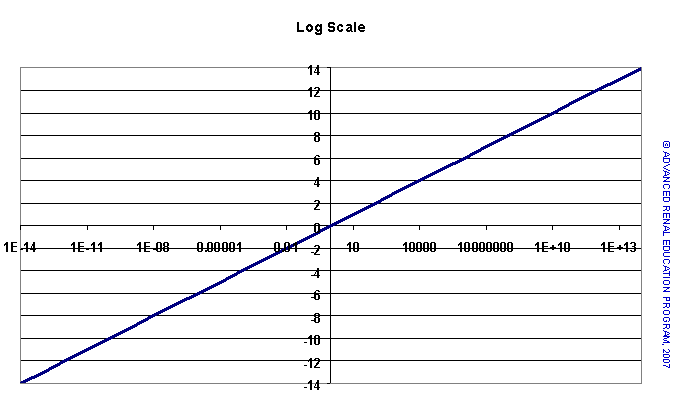Number Transformations
Sometimes the range of relevant values expressed in ordinary numbers is large and extends from the manageable to the unmanageable. Take for example the expression of hydrogen ion concentration ([H+]) as moles per liter. An extremely strong acid such as the HCl found on the shelf in a laboratory might have a [H+] of 0.1 mole per liter = 100 mmole/l. At the other extreme, a strong base would have a [H+] of less than 10 femtomole/l (0.00000000000001 mole/l; 10 x 10‑15 mole/l). Physiological solutions (e.g., plasma, intracellular water) have [H+] in the narrow range 10 to 160 nmole/l (10 x 10-9 to 160 x 10‑9 mole/l). This large range of fractions (decimals) becomes more manageable when transformed as logarithms, in this case logarithms to base-10: Log10.
The Log of 0.1 is minus 1 (-1). To avoid using the minus we can take the negative Log. The negative Log (-Log) of 0.1 is 1. The negative Log of 0.00000000000001 is 14. We can now express the complete range of interest of [H+] by the range of log numbers between -14 and +14. Obviously this is far more manageable. In calculation the mathematical conventions for logarithms must be observed. Log values can be converted back to ordinary numbers using the antilogarithm function (usually available as the POWER() function in spreadsheets).
The Log scale –14 to +14 which transforms the numerical range 10-14 to 1014 is shown in the chart below.
[1E-14 = 1*10-14; 1E+13 = 1*1013]Log conversion may also be used to convert a non-linear number series to a linear series. The next chart shows the rise in serum creatinine (mmol/L; read from the left Y-axis) over time in progressive renal failure (continuous dark curve). The broken line shows the natural Log (LogN) transformations of the serum creatinine values (read from the right Y-axis) and illustrates how log transformation converts a curvilinear series to a linear series. This transformation would be useful to predict a future value for creatinine which would be difficult from the curvilinear series.
Natural logarithms are logs to the base 2.71828 and are readily converted back to ordinary numbers by the use of the exponential function [Exp( )] on a spreadsheet or calculator.
P/N 101818-01 Rev B 02/2021


